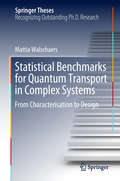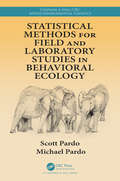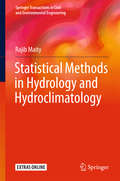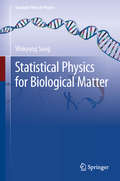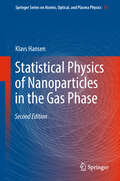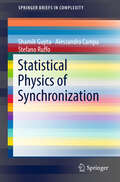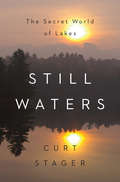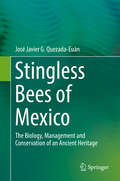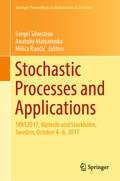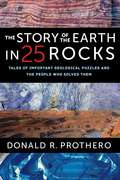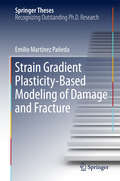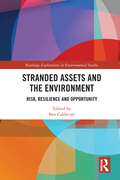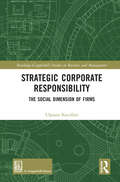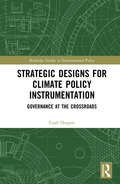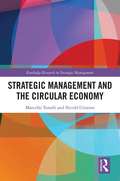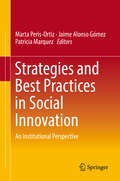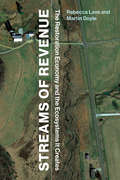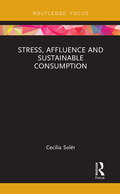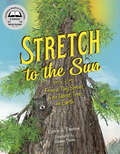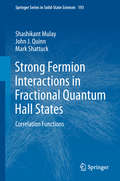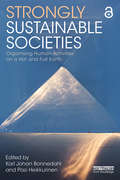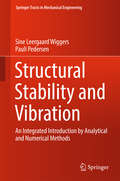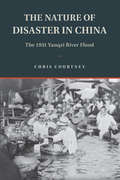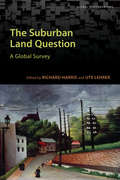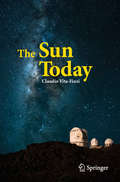- Table View
- List View
Statistical Benchmarks for Quantum Transport in Complex Systems: From Characterisation To Design (Springer Theses)
by Mattia WalschaersThis book introduces a variety of statistical tools for characterising and designing the dynamical features of complex quantum systems. These tools are applied in the contexts of energy transfer in photosynthesis, and boson sampling. In dynamical quantum systems, complexity typically manifests itself via the interference of a rapidly growing number of paths that connect the initial and final states. The book presents the language of graphs and networks, providing a useful framework to discuss such scenarios and explore the rich phenomenology of transport phenomena. As the complexity increases, deterministic approaches rapidly become intractable, which leaves statistics as a viable alternative.
Statistical Methods for Field and Laboratory Studies in Behavioral Ecology (Chapman & Hall/CRC Applied Environmental Statistics)
by Scott Pardo Michael PardoStatistical Methods for Field and Laboratory Studies in Behavioral Ecology focuses on how statistical methods may be used to make sense of behavioral ecology and other data. It presents fundamental concepts in statistical inference and intermediate topics such as multiple least squares regression and ANOVA. The objective is to teach students to recognize situations where various statistical methods should be used, understand the strengths and limitations of the methods, and to show how they are implemented in R code. Examples are based on research described in the literature of behavioral ecology, with data sets and analysis code provided. Features: This intermediate to advanced statistical methods text was written with the behavioral ecologist in mind Computer programs are provided, written in the R language. Datasets are also provided, mostly based, at least to some degree, on real studies. Methods and ideas discussed include multiple regression and ANOVA, logistic and Poisson regression, machine learning and model identification, time-to-event modeling, time series and stochastic modeling, game-theoretic modeling, multivariate methods, study design/sample size, and what to do when things go wrong. It is assumed that the reader has already had exposure to statistics through a first introductory course at least, and also has sufficient knowledge of R. However, some introductory material is included to aid the less initiated reader. Scott Pardo, Ph.D., is an accredited professional statistician (PStat®) by the American Statistical Association. Michael Pardo is a Ph.D. is a candidate in behavioral ecology at Cornell University, specializing in animal communication and social behavior.
Statistical Methods in Hydrology and Hydroclimatology (Springer Transactions in Civil and Environmental Engineering)
by Rajib MaityThis book focuses on the application of statistical methods in the field of hydrology and hydroclimatology. Among the latest theories being used in these fields, the book introduces the theory of copulas and its applications in this context. The purpose is to develop an understanding and illustrate the usefulness of the statistical techniques with detailed theory and numerous worked out examples. Apart from this, MATLAB-based codes and solutions of some worked out examples are also provided to assist the readers to handle real life data. This book presents a comprehensive knowledge of statistical techniques combining the basics of probability and the current advances in stochastic hydrology. Besides serving as a textbook for graduate courses on stochastic modeling in hydrology and related disciplines, the book offers valuable resources for researchers and professionals involved in the field of hydrology and climatology.
Statistical Physics for Biological Matter (Graduate Texts in Physics)
by Wokyung SungThis book aims to cover a broad range of topics in statistical physics, including statistical mechanics (equilibrium and non-equilibrium), soft matter and fluid physics, for applications to biological phenomena at both cellular and macromolecular levels. It is intended to be a graduate level textbook, but can also be addressed to the interested senior level undergraduate. The book is written also for those involved in research on biological systems or soft matter based on physics, particularly on statistical physics.Typical statistical physics courses cover ideal gases (classical and quantum) and interacting units of simple structures. In contrast, even simple biological fluids are solutions of macromolecules, the structures of which are very complex. The goal of this book to fill this wide gap by providing appropriate content as well as by explaining the theoretical method that typifies good modeling, namely, the method of coarse-grained descriptions that extract the most salient features emerging at mesoscopic scales. The major topics covered in this book include thermodynamics, equilibrium statistical mechanics, soft matter physics of polymers and membranes, non-equilibrium statistical physics covering stochastic processes, transport phenomena and hydrodynamics. Generic methods and theories are described with detailed derivations, followed by applications and examples in biology. The book aims to help the readers build, systematically and coherently through basic principles, their own understanding of nonspecific concepts and theoretical methods, which they may be able to apply to a broader class of biological problems.
Statistical Physics of Nanoparticles in the Gas Phase (Springer Series on Atomic, Optical, and Plasma Physics #73)
by Klavs HansenThermal processes are ubiquitous and an understanding of thermal phenomena is essential for a complete description of the physics of nanoparticles, both for the purpose of modeling the dynamics of the particles and for the correct interpretation of experimental data.The second edition of this book follows the logic of first edition, with an emphasis on presentation of literature results and to guide the reader through derivations. Several topics have been added to the repertoire, notably magnetism, a fuller exposition of aggregation and the related area of nucleation theory. Also a new chapter has been added on the transient hot electron phenomenon. The book remains focused on the fundamental properties of nanosystems in the gas phase. Each chapter is enriched with additional new exercises and three Appendices provide additional useful material.
Statistical Physics of Synchronization (SpringerBriefs in Complexity)
by Shamik Gupta Alessandro Campa Stefano RuffoThis book introduces and discusses the analysis of interacting many-body complex systems exhibiting spontaneous synchronization from the perspective of nonequilibrium statistical physics. While such systems have been mostly studied using dynamical system theory, the book underlines the usefulness of the statistical physics approach to obtain insightful results in a number of representative dynamical settings. Although it is intractable to follow the dynamics of a particular initial condition, statistical physics allows to derive exact analytical results in the limit of an infinite number of interacting units. Chapter one discusses dynamical characterization of individual units of synchronizing systems as well as of their interaction and summarizes the relevant tools of statistical physics. The latter are then used in chapters two and three to discuss respectively synchronizing systems with either a first- or a second-order evolution in time. This book provides a timely introduction to the subject and is meant for the uninitiated as well as for experienced researchers working in areas of nonlinear dynamics and chaos, statistical physics, and complex systems.
Still Waters: The Secret World Of Lakes
by Curt StagerA fascinating exploration of lakes around the world, from Walden Pond to the Dead Sea. More than a century and a half have passed since Walden was first published, and the world is now a very different place. Lakes are changing rapidly, not because we are separate from nature but because we are so much a part of it. While many of our effects on the natural world today are new, from climate change to nuclear fallout, our connections to it are ancient, as core samples from lake beds reveal. In Still Waters, Curt Stager introduces us to the secret worlds hidden beneath the surfaces of our most remarkable lakes, leading us on a journey from the pristine waters of the Adirondack Mountains to the wilds of Siberia, from Thoreau’s cherished pond to the Sea of Galilee. Through decades of firsthand investigations, Stager examines the significance of our impacts on some of the world’s most iconic inland waters. Along the way he discovers the stories these lakes contain about us, including our loftiest philosophical ambitions and our deepest myths. For him, lakes are not only mirrors reflecting our place in the natural world but also windows into our history, culture, and the primal connections we share with all life. Beautifully observed and eloquently written, Stager’s narrative is filled with strange and enchanting details about these submerged worlds—diving insects chirping underwater like crickets, African crater lakes that explode, and the growing threats to some of our most precious bodies of water. Modern science has demonstrated that humanity is an integral part of nature on this planet, so intertwined with it that we have also become an increasingly powerful force of nature in our own right. Still Waters reminds us how beautiful, complex, and vulnerable our lakes are, and how, more than ever, it is essential to protect them.
Stingless Bees of Mexico
by José Javier Quezada-EuánThe stingless bees are the most diverse group of highly social bees and are key species in our planet’s tropical and subtropical regions, where they thrive. In Mexico, the management of stingless bees dates back centuries, and they were an essential part of the culture and cosmogony of native peoples like the Maya. In recent decades a vast amount of information has been gathered on stingless bees worldwide. This book summarizes various aspects of the biology and management of stingless bees, with special emphasis on the Mexican species and the traditions behind their cultivation. Much of the information presented here was produced by the author and the team of researchers at the Universidad Autónoma de Yucatán in the course of three decades of working with these insects. Given the breadth of its coverage, the book offers an equally valuable reference guide for academics, students and beekeepers alike.
Stochastic Processes and Applications: SPAS2017, Västerås and Stockholm, Sweden, October 4-6, 2017 (Springer Proceedings in Mathematics & Statistics #271)
by Sergei Silvestrov Anatoliy Malyarenko Milica RančićThis book highlights the latest advances in stochastic processes, probability theory, mathematical statistics, engineering mathematics and algebraic structures, focusing on mathematical models, structures, concepts, problems and computational methods and algorithms important in modern technology, engineering and natural sciences applications.It comprises selected, high-quality, refereed contributions from various large research communities in modern stochastic processes, algebraic structures and their interplay and applications. The chapters cover both theory and applications, illustrated by numerous figures, schemes, algorithms, tables and research results to help readers understand the material and develop new mathematical methods, concepts and computing applications in the future. Presenting new methods and results, reviews of cutting-edge research, and open problems and directions for future research, the book serves as a source of inspiration for a broad spectrum of researchers and research students in probability theory and mathematical statistics, applied algebraic structures, applied mathematics and other areas of mathematics and applications of mathematics.The book is based on selected contributions presented at the International Conference on “Stochastic Processes and Algebraic Structures – From Theory Towards Applications” (SPAS2017) to mark Professor Dmitrii Silvestrov’s 70th birthday and his 50 years of fruitful service to mathematics, education and international cooperation, which was held at Mälardalen University in Västerås and Stockholm University, Sweden, in October 2017.
The Story of the Earth in 25 Rocks: Tales of Important Geological Puzzles and the People Who Solved Them
by Donald R. ProtheroEvery rock is a tangible trace of the earth’s past. The Story of the Earth in 25 Rocks tells the fascinating stories behind the discoveries that shook the foundations of geology. In twenty-five chapters—each about a particular rock, outcrop, or geologic phenomenon—Donald R. Prothero recounts the scientific detective work that shaped our understanding of geology, from the unearthing of exemplary specimens to tectonic shifts in how we view the inner workings of our planet. Prothero follows in the footsteps of the scientists who asked—and answered—geology’s biggest questions: How do we know how old the earth is? What happened to the supercontinent Pangea? How did ocean rocks end up at the top of Mount Everest? What can we learn about our planet from meteorites and moon rocks? He answers these questions through expertly chosen case studies, such as Pliny the Younger’s firsthand account of the eruption of Vesuvius; the granite outcrops that led a Scottish scientist to theorize that the landscapes he witnessed were far older than Noah’s Flood; the salt and gypsum deposits under the Mediterranean Sea that indicate that it was once a desert; and how trying to date the age of meteorites revealed the dangers of lead poisoning. Each of these breakthroughs filled in a piece of the greater puzzle that is the earth, with scientific discoveries dovetailing with each other to offer an increasingly coherent image of the geologic past. Summarizing a wealth of information in an entertaining, approachable style, The Story of the Earth in 25 Rocks is essential reading for the armchair geologist, the rock hound, and all who are curious about the earth beneath their feet.
Strain Gradient Plasticity-Based Modeling of Damage and Fracture
by Emilio Martínez PañedaThis book provides a comprehensive introduction to numerical modeling of size effects in metal plasticity. The main classes of strain gradient plasticity formulations are described and efficiently implemented in the context of the finite element method. A robust numerical framework is presented and employed to investigate the role of strain gradients on structural integrity assessment. The results obtained reveal the need of incorporating the influence on geometrically necessary dislocations in the modeling of various damage mechanisms. Large gradients of plastic strain increase dislocation density, promoting strain hardening and elevating crack tip stresses. This stress elevation is quantified under both infinitesimal and finite deformation theories, rationalizing the experimental observation of cleavage fracture in the presence of significant plastic flow. Gradient-enhanced modeling of crack growth resistance, hydrogen diffusion and environmentally assisted cracking highlighted the relevance of an appropriate characterization of the mechanical response at the small scales involved in crack tip deformation. Particularly promising predictions are attained in the field of hydrogen embrittlement. The research has been conducted at the Universities of Cambridge, Oviedo, Luxembourg, and the Technical University of Denmark, in a collaborative effort to understand, model and optimize the mechanical response of engineering materials.
Stranded Assets and the Environment: Risk, Resilience and Opportunity (Routledge Explorations in Environmental Studies)
by Ben CaldecottDrawing on the work of leading researchers and practitioners from a range of disciplines, including economic geography, economics, economic history, finance, law, and public policy, this edited collection provides a comprehensive assessment of stranded assets and the environment, covering the fundamental issues and debates, including climate change and societal responses to environmental change, as well as its origins and theoretical basis. The volume provides much needed clarity as the discourse on stranded assets gathers further momentum. In addition to drawing on scholarly contributions, there are chapters from practitioners and analysts to provide a range of critical perspectives. While chapters have been written as important standalone contributions, the book is intended to systematically take the reader through the key dimensions of stranded assets as a topic of research inquiry and practice. The work adopts a broad based social science perspective for setting out what stranded assets are, why they are relevant, and how they might inform the decision-making of firms, investors, policymakers, and regulators. The topic of stranded assets is inherently multi-disciplinary, cross-sectoral, and multi-jurisdictional and the volume reflects this diversity. This book will be of great relevance to scholars, practitioners and policymakers with an interest in include economics, business and development studies, climate policy and environmental studies in general.
Strategic Corporate Responsibility: The Social Dimension of Firms (Routledge-Giappichelli Studies in Business and Management)
by Ulpiana KocollariIn her book, Dr Ulpiana Kocollari presents a unique contribution to the debate on Corporate Social Responsibility and Sustainability by clearly expressing how the configuration of a firm’s social dimension can help identify inclusive corporate governance models, define innovative management processes and reshape performance measurement systems for the evaluation and assessment of sustainable economic, social and environmental results. Moving a step further, a firm’s social dimension is defined within the configuration of stakeholders – resources – rewards patterns intrinsic to their interactions with their environment and embedded in their business activities. Based on this approach, a framework is provided to guide firms in identifying management activities grounded in and suited to their prevalent patterns, in order to support current and future strategies and establish adequate measurement and communication tools for pursuing their mission. The book contains original theoretical and empirical material and particular attention is paid to the principal social and environmental impact measurement models (i.e. Global Reporting Initiative, Social Return on Investments, Social Balanced Scorecard, etc.), analysing their main features in order to pinpoint their adequacy in assessing the social dimension and to tailor their use more closely to the specific patterns to which they refer. Finally, a detailed application of the analysis framework, which the author has identified is proposed for Innovative Start-Ups with a Social Goal and for Benefit Corporations, in order to detect the patterns embedded in their social dimension and their distinctive traits, which influence their management and measurement processes.
Strategic Designs for Climate Policy Instrumentation: Governance at the Crossroads (Routledge Studies in Environmental Policy)
by Gjalt HuppesThis book provides insight into the development of effective climate policy instrumentation in two divergent and mutually exclusive directions. Examining the role of political philosophies, the book explains why current climate policy is ineffective and unable to halt rapidly rising atmospheric concentrations of CO2, and suggests strategies for ending the current stalemate in climate governance. Drawing on examples from real-world case studies and challenges, the author first sets out an instrumentation approach based on a command and control strategy which involves identifying the technologies and behavior key to meeting the required emissions reductions, such as energy efficient homes and zero-emission cars. The second strategy concerns institutional rearrangement, creating incentives and options which will allow for decentralized climate action. This approach would transform and strengthen current emission trading systems, such as the EU ETS, into a price stabilized system covering all fossil fuels, and ultimately as an emission tax, as well as creating an open electricity market. These approaches not only highlight that fundamental changes in climate policy instrumentation are now vital, but that consistent strategies such as those laid out by the author are necessary if we are to avoid costly and ineffective alternatives. Exploring key issues such as the relationship between instrumentation and broader political philosophy, as well as applying a systems oriented design methodology for effective instrumentation, this book will be of great relevance to scholars and policy makers with an interest in climate change and environmental politics.
Strategic Management and the Circular Economy (Routledge Research in Strategic Management)
by Marcello Tonelli Nicolò CristoniIn recent years, the Circular Economy (CE) has gained worldwide attention as an effective alternative economic system to the current take-make-waste model of production and consumption. As more and more firms begin to recognize the potential of this novel approach, the CE quickly moves from theory to practice and the demand for a coherent and structured strategic approach – one that companies can rely upon when commencing their circular journey – grows accordingly. Strategic Management and the Circular Economy aims to bridge the theory-practice gap by putting forward a detailed step-by-step process for analysis, formulation, and planning of CE strategies. Starting from a solid framework of easy-to-grasp constructs (key principles, business objectives and areas of intervention), the authors guide the reader through an understanding of how conventional tools for strategic management can be re-programed under a CE perspective. To assist learning and encourage circular thinking, the reader is constantly prompted with examples of how forward-looking companies across industries and geographies are already applying circular strategies to future-proof their operations, boost innovation, penetrate new markets and secure customer loyalty.
Strategies and Best Practices in Social Innovation: An Institutional Perspective
by Marta Peris-Ortiz Jaime Alonso Gómez Patricia MarquezThis book examines the different ways companies can develop and design social innovation. Combining technological and social perspectives, the contributors present emerging research on social innovation from different sectors such as entrepreneurship, education and energy. Collectively, the authors demonstrate the ways in which social innovation can drive sustainability and development in regions around the world. All societies are characterized by their political, economic and social institutions, as well as by how they utilize technology. The social innovations with the highest importance are those which modify existing institutions or create new ones, and based on their magnitude, they can be considered as radical or incremental. For example, when Joseph Chamberlain encouraged workers to organize in order to achieve universal male suffrage in Great Britain in 1885, this was a considered a radical innovation for British society, which in turn changed its political framework. Social innovations may be based on intelligence and commitment, on technology or on social entrepreneurship in its most open forms. In addition, social innovations can be classified into those which correspond to an entire country or region, a field (e.g., education) or a sector (e.g., entrepreneurship, technology, social reform). Featuring contributions on topics such as agro-food, smart cities, higher education, gender equality and sports, this book is ideal for academics, students, scholars, professionals and policy makers in the areas of innovation, entrepreneurship, sustainability and regional development.
Streams of Revenue: The Restoration Economy and the Ecosystems It Creates
by Rebecca Lave Martin DoyleAn analysis of stream mitigation banking and the challenges of implementing market-based approaches to environmental conservation.Market-based approaches to environmental conservation have been increasingly prevalent since the early 1990s. The goal of these markets is to reduce environmental harm not by preventing it, but by pricing it. A housing development on land threaded with streams, for example, can divert them into underground pipes if the developer pays to restore streams elsewhere. But does this increasingly common approach actually improve environmental well-being? In Streams of Revenue, Rebecca Lave and Martin Doyle answer this question by analyzing the history, implementation, and environmental outcomes of one of these markets: stream mitigation banking.
Stress, Affluence and Sustainable Consumption (Routledge Studies in Sustainability)
by Cecilia SolérWhy do affluent consumers almost automatically acquire new versions or variations of products already at their disposal? Even though most of us know that this novelty consumption poses a serious threat to an environmentally and socially sustainable future, we continue to do it. Why? Research shows that consumption of new automobiles, clothing, furniture, electronics, home furnishing, household apparel, mobile phones, etc., is motivated by a desire to feel more secure, less anxious and better mood-wise. Affluent consumers seem to engage in novelty consumption not to feel better but rather to avoid feeling bad. Stress, Affluence and Sustainable Consumption discusses sustainable consumption from a stress perspective, adding an embodied understanding to the sustainability-related consumption challenges that we face today. A stress perspective on affluent consumption differs from current understandings on consumption, as it fully acknowledges the consumer as having a body (including a mind) that reacts to the numerous product offerings and retail spaces, both physical and online. A stress perspective can explain how our bodies try to cope with an overload of perceptual input provided by advertising messages, product launches and even store structures. This book will be of great interest to students and researchers of consumer psychology, sustainable consumption studies, sustainable marketing and markets as well as sustainable development more generally.
Stretch to the Sun: From a Tiny Sprout to the Tallest Tree on Earth
by Carrie A. Pearson"Visually appealing and enjoyable to read aloud, this book is a versatile introduction to redwood trees and forest conservation."—School Library Journal Step into the magical, but true, world of a coast redwood forest -- one of nature's most diverse environments. Experience the life of one tiny tree as it survives despite all odds and grows generation by generation into the tallest tree on earth today. A recipient of a silver Eureka! Award from the California Reading Association for outstanding nonfiction. A children's book about how a once tiny seedling, deep in the forest of Redwood National Park, that was protected by the animals and plants that surrounded it, stretched toward the sun to become the tallest known tree on earth. It survived ecological and human threats and flourished for over 1200 years. Logging in the nineteenth and twentieth centuries depleted the coastal redwood population significantly. But the creation of northern California's Redwood National Park in 1968 helped to save some of the ancient trees, like this one. The tree was discovered by tall tree scientists in 2006, but in the hopes to keep the tree safe, its exact location is kept secret.Susan Swan&’s eye-catching illustrations are made of found objects and hand-painted papers bringing a natural depth and texture to the story. Peppered with impressive facts about trees and extensive backmatter, Pearson proves that every tree has a story to tell.
Strong Fermion Interactions in Fractional Quantum Hall States: Correlation Functions (Springer Series In Solid-state Sciences Ser. #193)
by Shashikant Mulay John J. Quinn Mark ShattuckThis monograph presents an intuitive theory of trial wave functions for strongly interacting fermions in fractional quantum Hall states. The correlation functions for the proposed fermion interactions follow a novel algebraic approach that harnesses the classical theory of invariants and semi-invariants of binary forms. This approach can be viewed as a fitting and far-reaching generalization of Laughlin’s approach to trial wave functions. Aesthetically viewed, it illustrates an attractive symbiosis between the theory of invariants and the theory of correlations. Early research into numerical diagonalization computations for small numbers of electrons shows strong agreement with the constructed trial wave functions.The monograph offers researchers and students of condensed matter physics an accessible discussion of this interesting area of research.
Strongly Sustainable Societies: Organising Human Activities on a Hot and Full Earth (Routledge Studies in Sustainability)
by Karl Johan Bonnedahl Pasi HeikkurinenThe response of the international community to the pressing socio-ecological problems has been framed around the concept of ‘sustainable development’. The ecological pressure, however, has continued to rise and mainstream sustainability discourse has proven to be problematic. It contains an instrumental view of the world, a strong focus on technological solutions, and the premise that natural and human-made ‘capitals’ are substitutable. This trajectory, which is referred to as ‘weak sustainability’, reproduces inequalities, denies intrinsic values in nature, and jeopardises the wellbeing of humans as well as other beings. Based on the assumptions of strong sustainability, this edited book presents practical and theoretical alternatives to today’s unsustainable societies. It investigates and advances pathways for humanity that are ecologically realistic, ethically inclusive, and receptive to the task’s magnitude and urgency. The book challenges the traditional anthropocentric ethos and ontology, economic growth-dogma, and programmes of ecological modernisation. It discusses options with examples on different levels of analysis, from the individual to the global, addressing the economic system, key sectors of society, alternative lifestyles, and experiences of local communities. Examining key topics including human–nature relations and wealth and justice, this book will be of great interest to students and scholars of environmental and development studies, ecological economics, environmental governance and policy, sustainable business, and sustainability science.
Structural Stability and Vibration
by Sine Leergaard Wiggers Pauli PedersenThis book offers an integrated introduction to the topic of stability and vibration. Strikingly, it describes stability as a function of boundary conditions and eigenfrequency as a function of both boundary conditions and column force. Based on a post graduate course held by the author at the University of Southern Denmark, it reports on fundamental formulas and makes uses of graphical representation to promote understanding. Thanks to the emphasis put on analytical methods and numerical results, the book is meant to make students and engineers familiar with all fundamental equations and their derivation, thus stimulating them to write interactive and dynamic programs to analyze instability and vibrational modes.
Studies in Environment and History: The 1931 Yangzi River Flood (Studies in Environment and History)
by Chris CourtneyIn 1931, China suffered a catastrophic flood that claimed millions of lives. This was neither a natural nor human-made disaster. Rather, it was created by an interaction between the environment and society. Regular inundation had long been an integral feature of the ecology and culture of the middle Yangzi, yet by the modern era floods had become humanitarian catastrophes. Courtney describes how the ecological and economic effects of the 1931 flood pulse caused widespread famine and epidemics. He takes readers into the inundated streets of Wuhan, describing the terrifying and disorientating sensory environment. He explains why locals believed that an angry Dragon King was causing the flood, and explores how Japanese invasion and war with the Communists inhibited both official relief efforts and refugee coping strategies. This innovative study offers the first in-depth analysis of the 1931 flood, and charts the evolution of one of China's most persistent environmental problems.
The Suburban Land Question: A Global Survey (Global Suburbanisms)
by Richard Harris Ute LehrerAs part of the urbanization process, suburban development involves the conversion of rural land to urban use. When discussing the suburbs, most writers focus on particular countries in the northern hemisphere, implying that patterns and processes elsewhere are fundamentally different. The purpose of The Suburban Land Question is to identify the common elements of suburban development, focusing on issues associated with the scale and pace of rapid urbanization around the world. Editors Richard Harris and Ute Lehrer and a diverse group of contributors draw on a variety of sources, including official data, planning documents, newspapers, interviews, photographs, and field observations to explore the pattern, process, and planning of suburban land development. Featuring case studies from major world regions, including China, India, Latin America, South Africa, as well as France, Austria, the Netherlands, the United States, and Canada, the volume identifies and discusses the peculiarly transitional character of suburban land. In addition to place and time, The Suburban Land Question addresses the many elements that distinguish land development in urban fringe areas, including economy, social infrastructure, and legality.
The Sun Today
by Claudio Vita-FinziThere are several billion stars in the Milky Way galaxy. One of them is the middle-aged G2V yellow dwarf that rules our lives. The Sun Today discusses the Sun’s appearance and composition, its internal workings, and the various kinds of radiation it emits, and it puts forward a novel explanation for coronal heating. The book draws on the findings of telescopic observation, space missions, and technical and theoretical advances in many fields, and shows why we need to know more if we are to understand and manage our foothold in the Universe.
